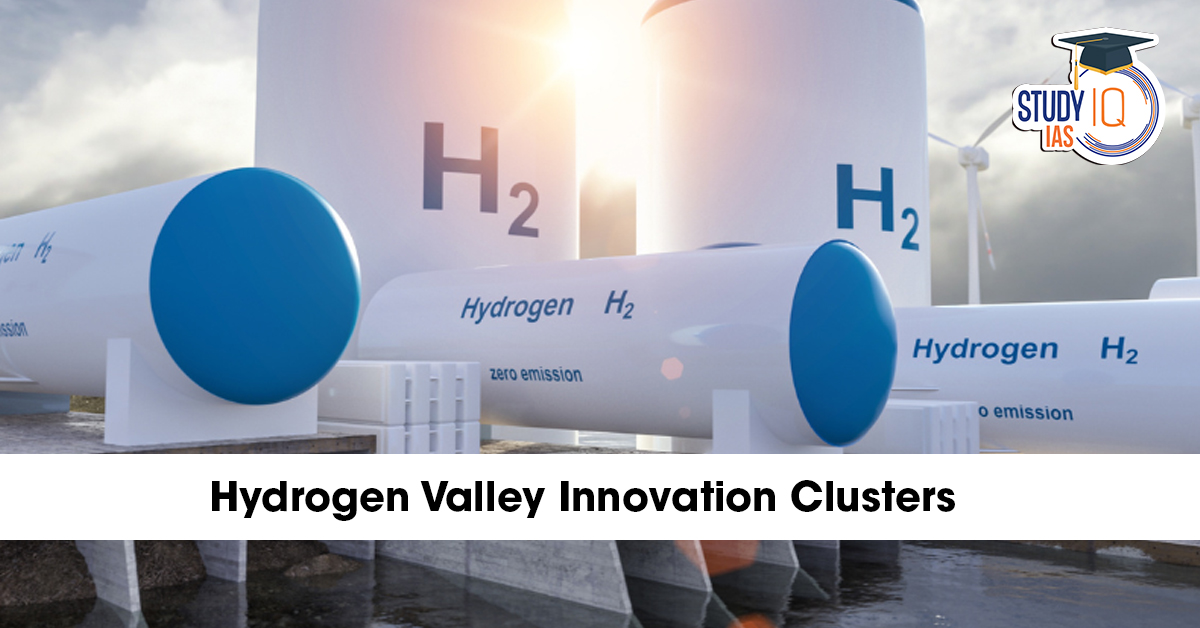Table of Contents
India is rapidly moving toward a clean energy future, and one of the most ambitious steps in this direction is the creation of Hydrogen Valley Innovation Clusters (HVICs). These clusters will demonstrate the full green hydrogen value chain, from production to end-use applications, making India a global hub for hydrogen innovation.
This article covers the latest news, objectives, funding, locations, significance, and UPSC-relevant details about HVICs.
Latest News on Hydrogen Valley Innovation Clusters
The Union Minister of State (Independent Charge) for Science and Technology recently announced that four Hydrogen Valley Innovation Clusters are being developed across India. These clusters are now officially integrated under the National Green Hydrogen Mission (NGHM).
Locations of HVICs
The four Hydrogen Valleys are being set up in:
-
Pune (Maharashtra)
-
Jodhpur (Rajasthan)
-
Bhubaneswar (Odisha)
-
Kerala (proposed around Kochi)
What Are Hydrogen Valley Innovation Clusters (HVICs)?
Hydrogen Valley Innovation Clusters are integrated regional ecosystems that demonstrate the entire cycle of green hydrogen production, storage, transport, and utilization—all within a single geographical area.
They aim to replicate the “hydrogen valley” model successfully used in Europe and other global hydrogen-leading regions.
Objectives of Hydrogen Valley Innovation Clusters
1. Build a Local Hydrogen Ecosystem
Connecting hydrogen producers, storage units, transport systems, and consumers to create a closed-loop hydrogen economy.
2. Promote Research, Innovation & Skill Development
Improve India’s hydrogen technologies through:
-
Pilot projects
-
Test beds
-
R&D labs
-
Industry–academia collaboration
3. Accelerate Adoption in Key Sectors
Hydrogen will be tested and used in:
-
Transportation (buses, trucks, ships)
-
Industrial processes (steel, refineries, fertilizers)
-
Power generation
-
Energy storage
4. Support India’s Clean Energy Transition
Contributes directly to:
-
India’s Net Zero 2070 target
-
Reduction of fossil fuel imports
-
Lowering carbon emissions in hard-to-abate sectors
Funding for HVICs
-
Total Investment: ₹485 crore
-
Originally conceptualized by the Department of Science and Technology (DST)
-
Now aligned with the National Green Hydrogen Mission (NGHM)
-
Funds support:
-
Green hydrogen production plants
-
Storage infrastructure
-
Transport pipelines & mobility pilots
-
Industry-level demonstration projects
-
Significance of Hydrogen Valley Innovation Clusters
1. Boosts Domestic Manufacturing
Encourages Indian production of:
-
Electrolysers
-
Fuel cells
-
Hydrogen storage tanks
-
Mobility technology
2. Creates Green Jobs
Direct and indirect jobs in:
-
Engineering
-
Manufacturing
-
R&D
-
Renewables
3. Attracts Global Investments
Makes India an attractive destination for:
-
Clean-tech startups
-
Hydrogen-focused MNCs
-
International collaborations
4. Reduces Industrial Emissions
Hydrogen valleys will demonstrate clean alternatives for:
-
Steelmaking
-
Ammonia/fertilizer production
-
Heavy transport fuel
What Is Green Hydrogen?
Green hydrogen is produced using renewable energy-based electrolysis, where water is split into hydrogen and oxygen using solar or wind power.
Government Standard for Green Hydrogen
Hydrogen is considered green when:
-
Emissions ≤ 2 kg CO₂ equivalent per 1 kg hydrogen produced
Green hydrogen can also be produced from biomass or agricultural waste, provided emissions stay below this limit.
Why India Needs Hydrogen Valleys
-
To reduce dependence on imported fossil fuels
-
To decarbonize heavy industries
-
To achieve energy security
-
To become a global hydrogen export hub
-
To integrate renewable energy more efficiently
Challenges Ahead
-
High cost of electrolysers
-
Need for large-scale renewable energy availability
-
Infrastructure for storage and transport
-
Industry adoption barriers
-
Skilled manpower shortage
Government Initiatives Supporting HVICs
-
National Green Hydrogen Mission (NGHM) – ₹19,744 crore
-
Green Hydrogen Standards (2023)
-
PLI Scheme for Electrolysers
-
Strategic collaborations with Japan, EU, Australia, and Nordic countries
Conclusion
The Hydrogen Valley Innovation Clusters represent a major leap in India’s clean energy ecosystem. By building localized hydrogen economies, India is positioning itself as a global leader in green hydrogen production, innovation, and commercialization.
These clusters will not only boost sustainability but also strengthen India’s industrial competitiveness and technological capabilities.


 Global Carbon Project Report on India’...
Global Carbon Project Report on India’...
 Key Methods of DNA Identification: Techn...
Key Methods of DNA Identification: Techn...
 State of the Cryosphere 2025 Report: Key...
State of the Cryosphere 2025 Report: Key...

























